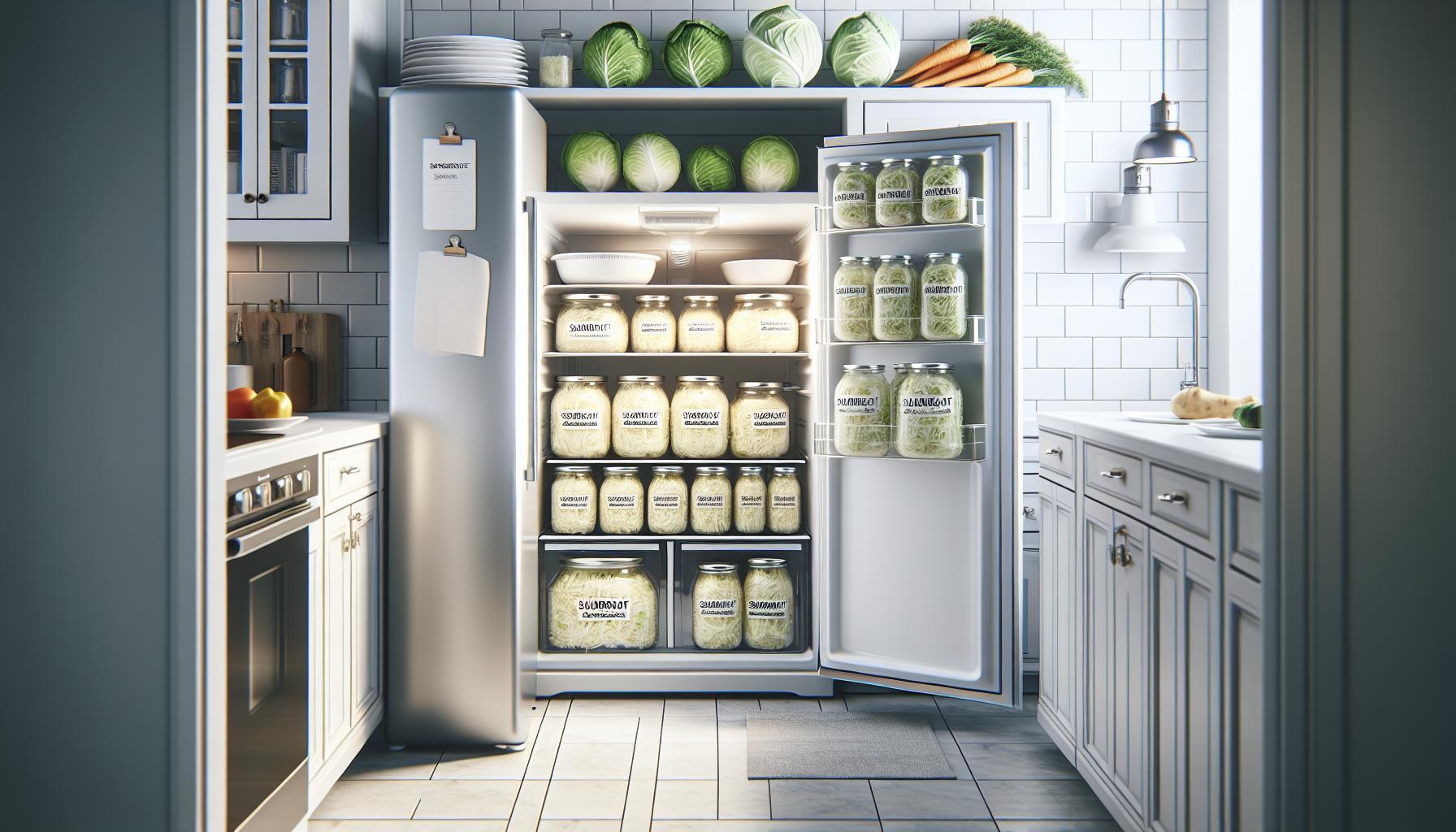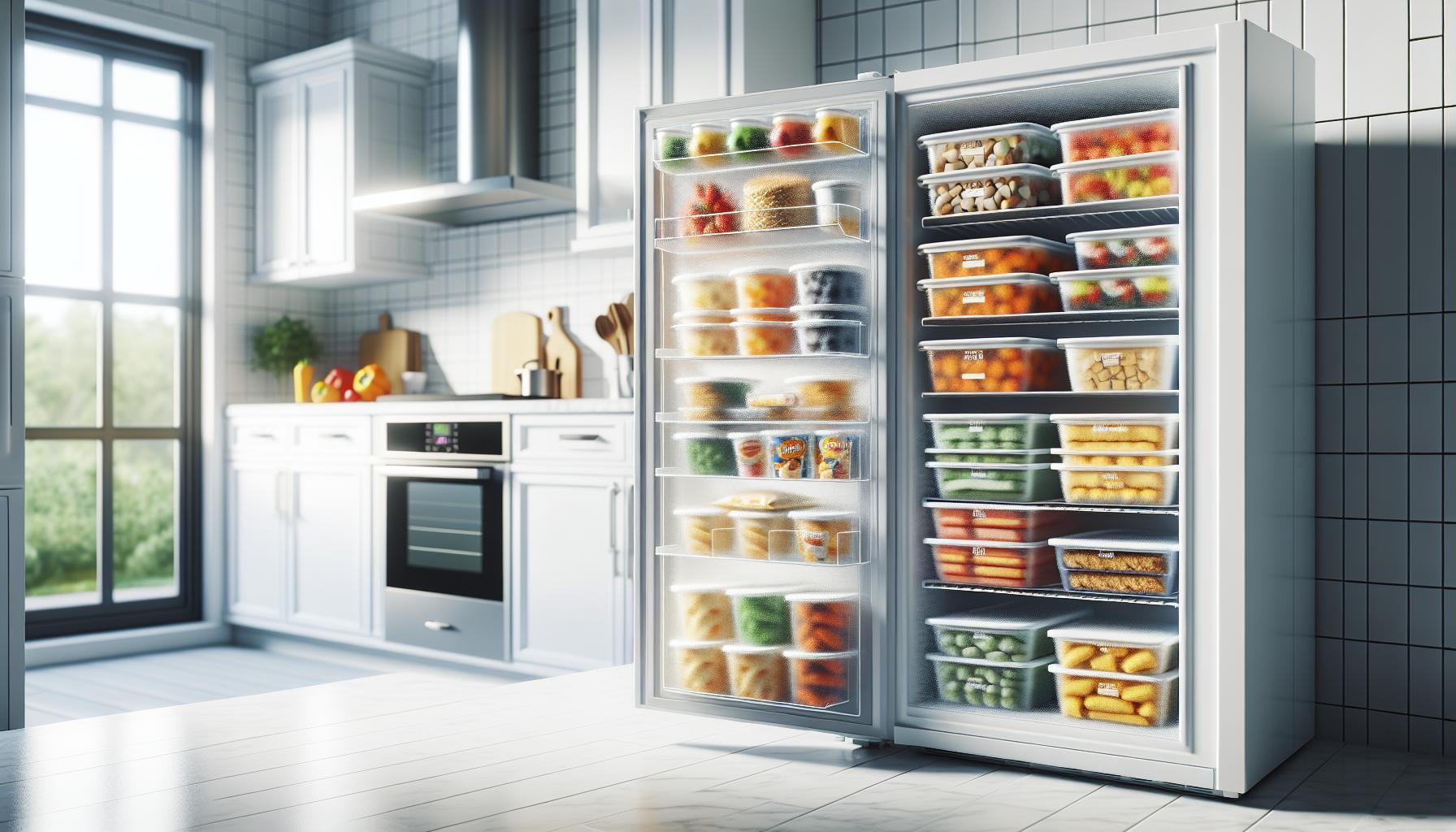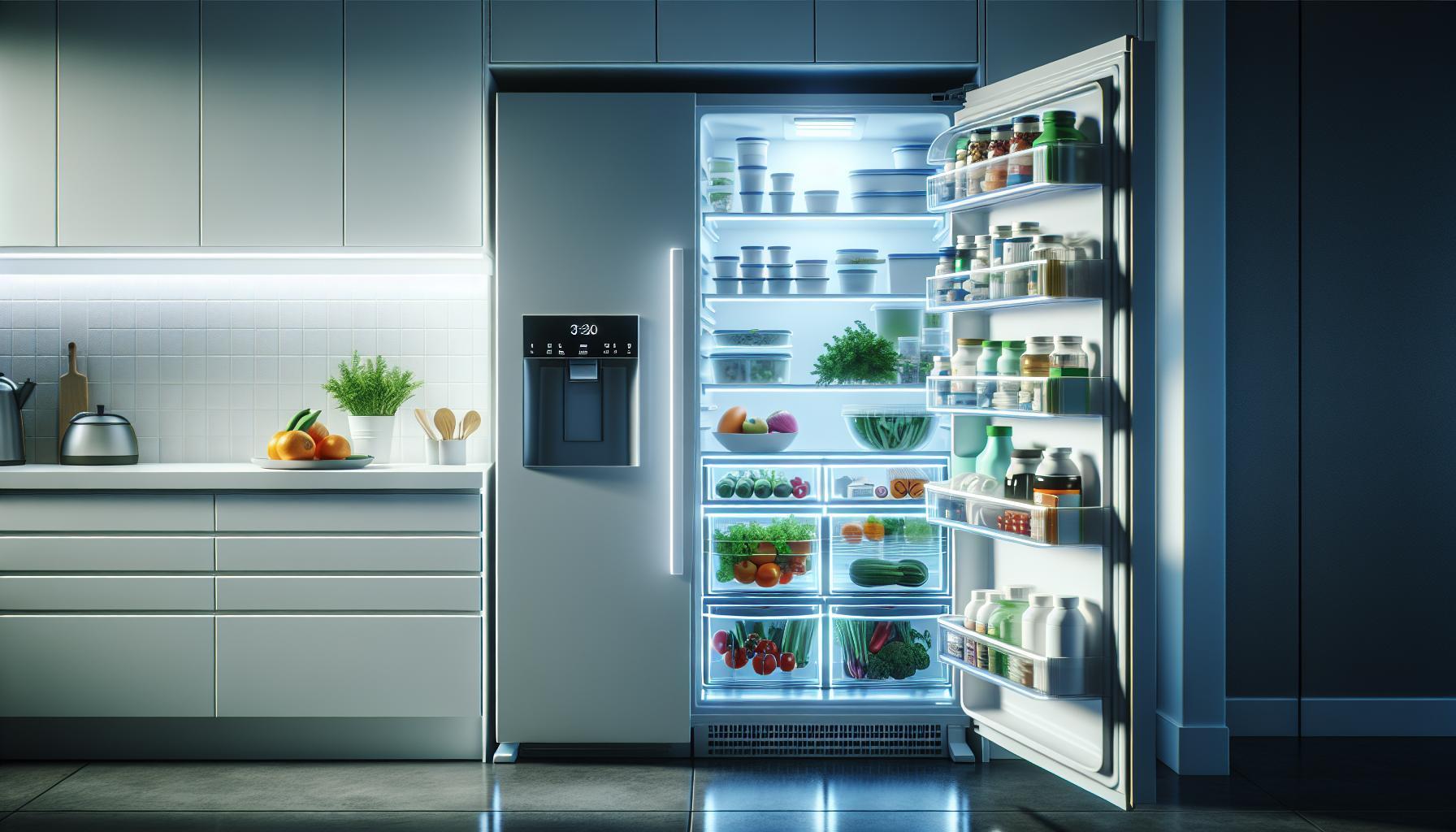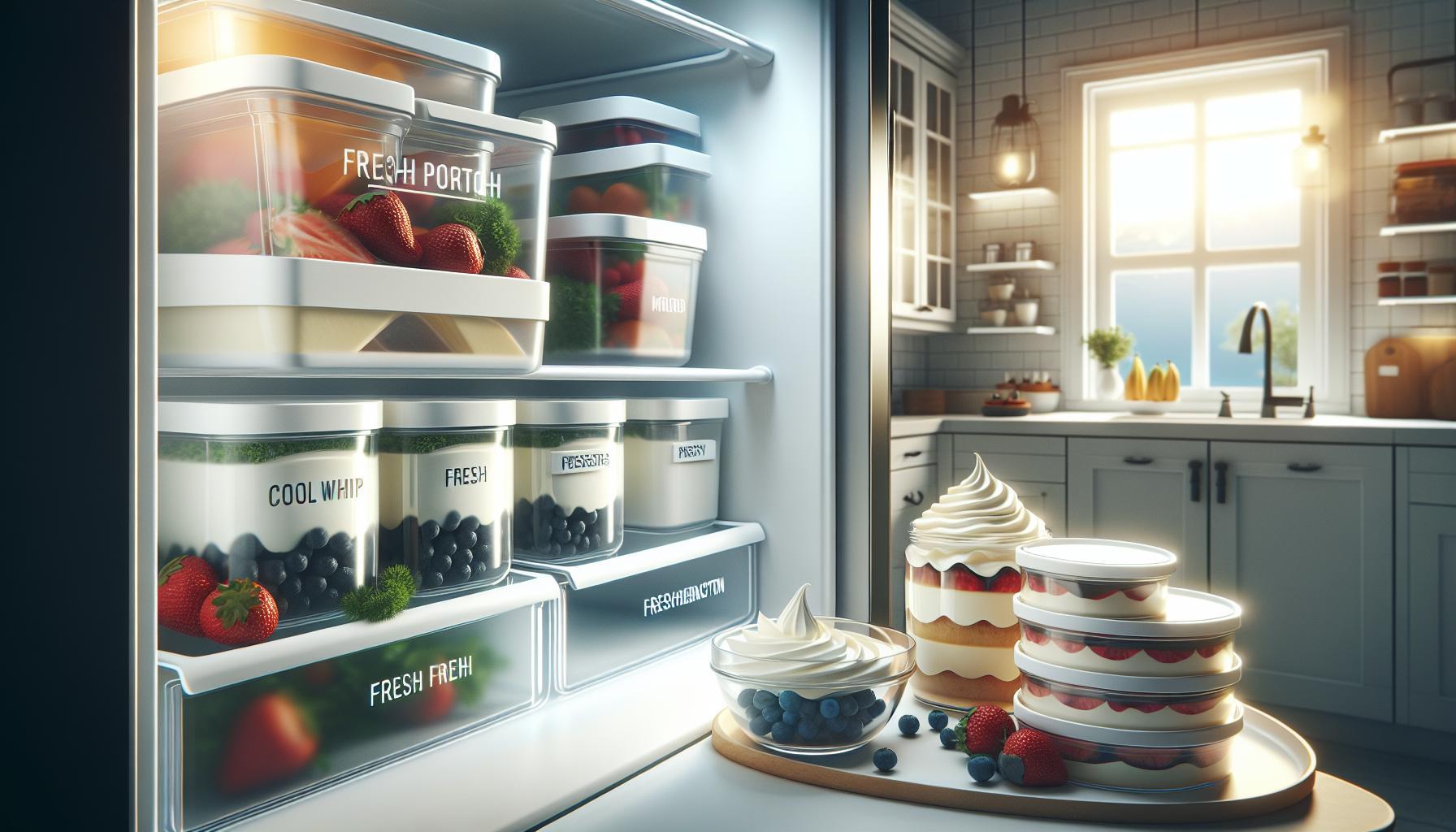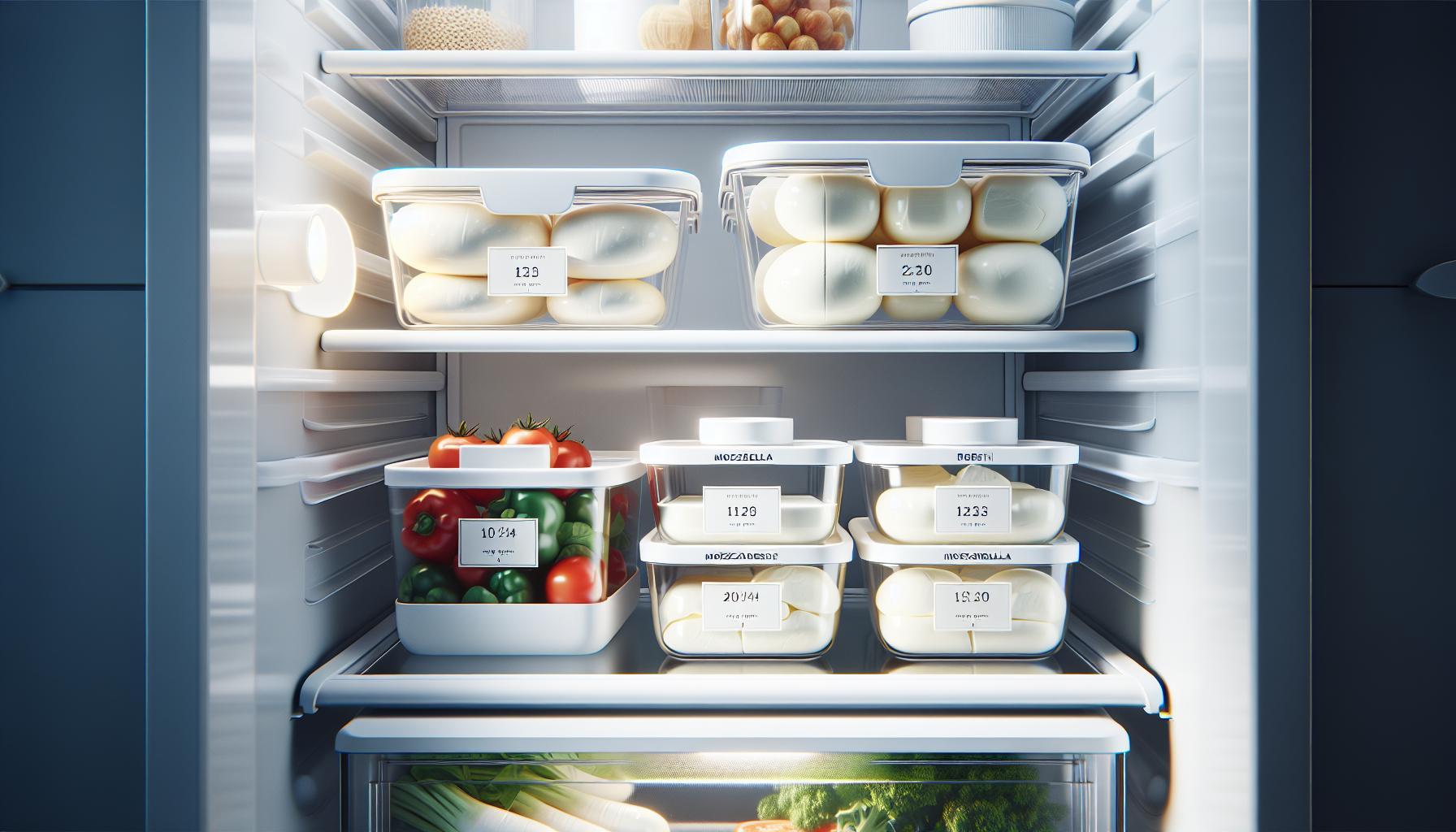Sauerkraut is not only a delicious addition to many meals but also a powerhouse of probiotics, making it a staple in kitchens worldwide. Properly stored, this fermented food can last for weeks in the fridge, but understanding its shelf life is crucial for both safety and quality.
Many people struggle with knowing how long their sauerkraut will stay fresh after opening, leading to concerns about spoilage and waste. Whether you’re new to fermenting or simply looking to optimize your storage practices, having clear guidelines can help you enjoy this tangy treat to its fullest.
In this article, we’ll explore how long sauerkraut lasts in the fridge, providing you with straightforward storage tips and safety information to ensure your ferments remain delicious and safe to eat. Keep reading to learn how to keep your sauerkraut fresh and flavorful!
How Long Does Sauerkraut Last in the Fridge?
Sauerkraut, a staple of fermented foods, boasts an impressive shelf life, especially when stored in the refrigerator. For optimal freshness and flavor, homemade or store-bought sauerkraut can typically last one to two months in the fridge after opening-although it can remain edible for much longer. Its longevity is primarily due to the acidity created during fermentation, which acts as a natural preservative. However, even after several months, the sauerkraut may continue to be safe to eat, though its taste and texture might not be at their peak.
To ensure your sauerkraut maintains its quality for an extended period, store it in an airtight container to minimize exposure to air. This limits the growth of unwanted bacteria and mold. If you notice a slight change in color or flavor, as long as there’s no off-putting smell or visible mold on the surface, it’s generally safe to eat; just make sure to mix it well before serving.
Different factors can affect storage longevity, including the amount of salt used during fermentation and the initial quality of the cabbage. High-salt sauerkraut may last slightly longer than its low-salt counterparts, while commercially packaged varieties often contain preservatives that can extend their shelf life beyond the recommended time frame. Always check the “best by” date on store-bought products and practice good food safety to keep your sauerkraut tasting its best.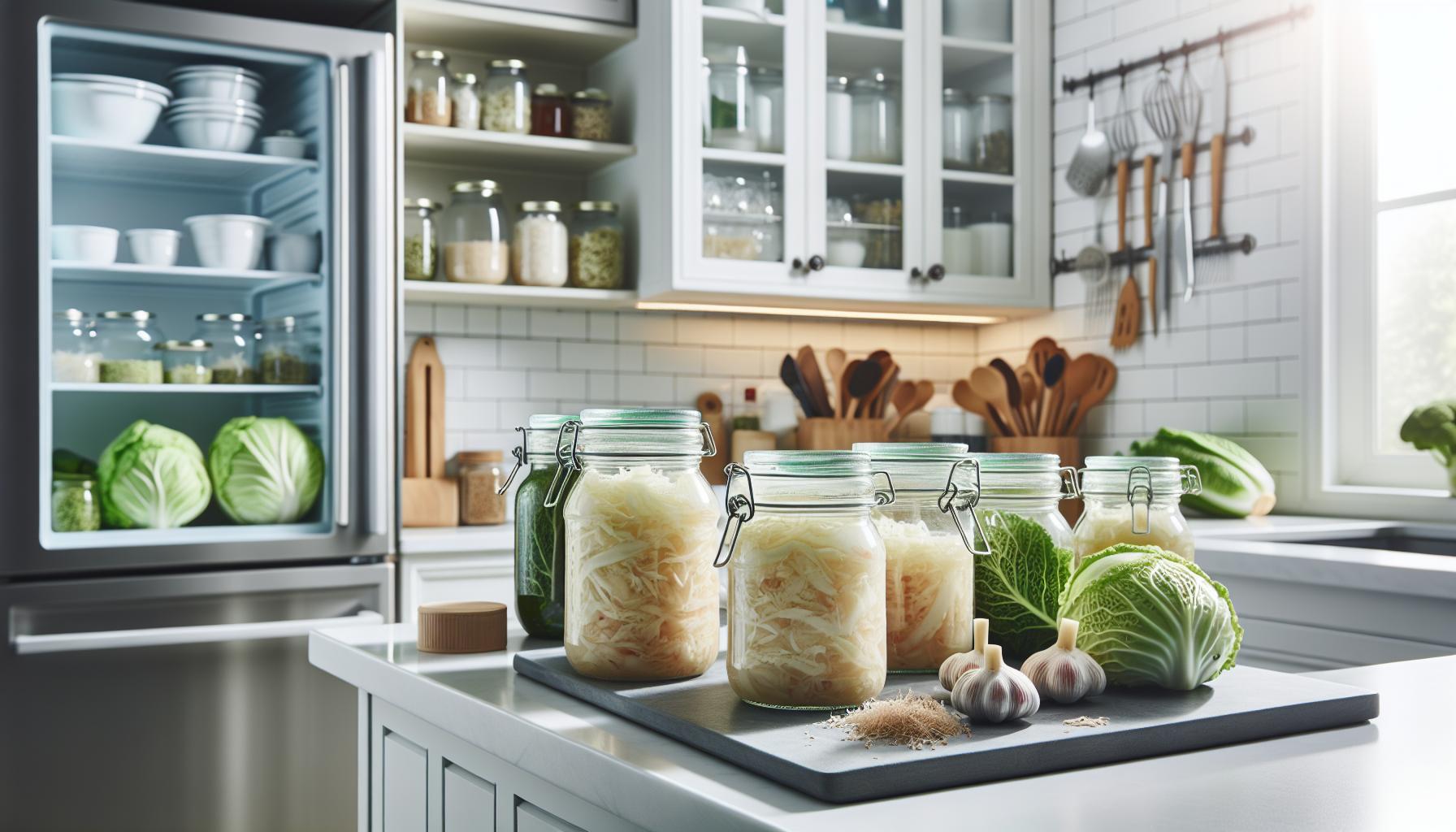
Understanding the Fermentation Process of Sauerkraut
The transformation of cabbage into sauerkraut is a fascinating process that intertwines science and art, relying on the natural power of fermentation. At its core, fermentation is a metabolic process where microorganisms like bacteria and yeasts convert sugars into acids, gases, or alcohol. When it comes to sauerkraut, the primary player is lactic acid bacteria, which thrive in an anaerobic environment (one without oxygen) created during the fermentation process. This shift not only preserves the cabbage but also enhances its flavor and nutritional profile.
When cabbage is shredded and mixed with salt, the salt draws out water from the cabbage, creating a brine solution. This brine is essential as it submerges the shredded cabbage, preventing unwanted aerobic bacteria from thriving. The lactic acid bacteria present on the cabbage begin to feast on the sugars found in the vegetable, producing lactic acid as a byproduct. This acidification process lowers the pH of the mixture, inhibiting harmful bacteria while promoting the growth of beneficial ones. This cycle of fermentation can last anywhere from a few days to several weeks, depending on the desired flavor and the temperature at which it is stored.
Fermentation is not just a method of preservation; it is also a means of enhancing the health benefits of food. Sauerkraut is rich in probiotics, which are beneficial for gut health. These live microorganisms can aid digestion, boost the immune system, and may even contribute to mental well-being. Additionally, the fermentation process increases the bioavailability of certain nutrients, making vitamins and minerals more accessible to the body. This unique process illustrates why sauerkraut not only serves as a delicious complement to meals but also as a powerhouse of health.
To ensure that the sauerkraut retains its beneficial properties and remains safe to consume over time, it’s crucial to follow proper storage practices. Always keep sauerkraut in a sealed container in the refrigerator to maintain its quality and slow down further fermentation. It’s also a good idea to check for any changes in smell, color, or texture, as these can serve as indicators of spoilage. Proper understanding of the fermentation process can empower consumers to enjoy this traditional food while maximizing its health benefits and minimizing waste.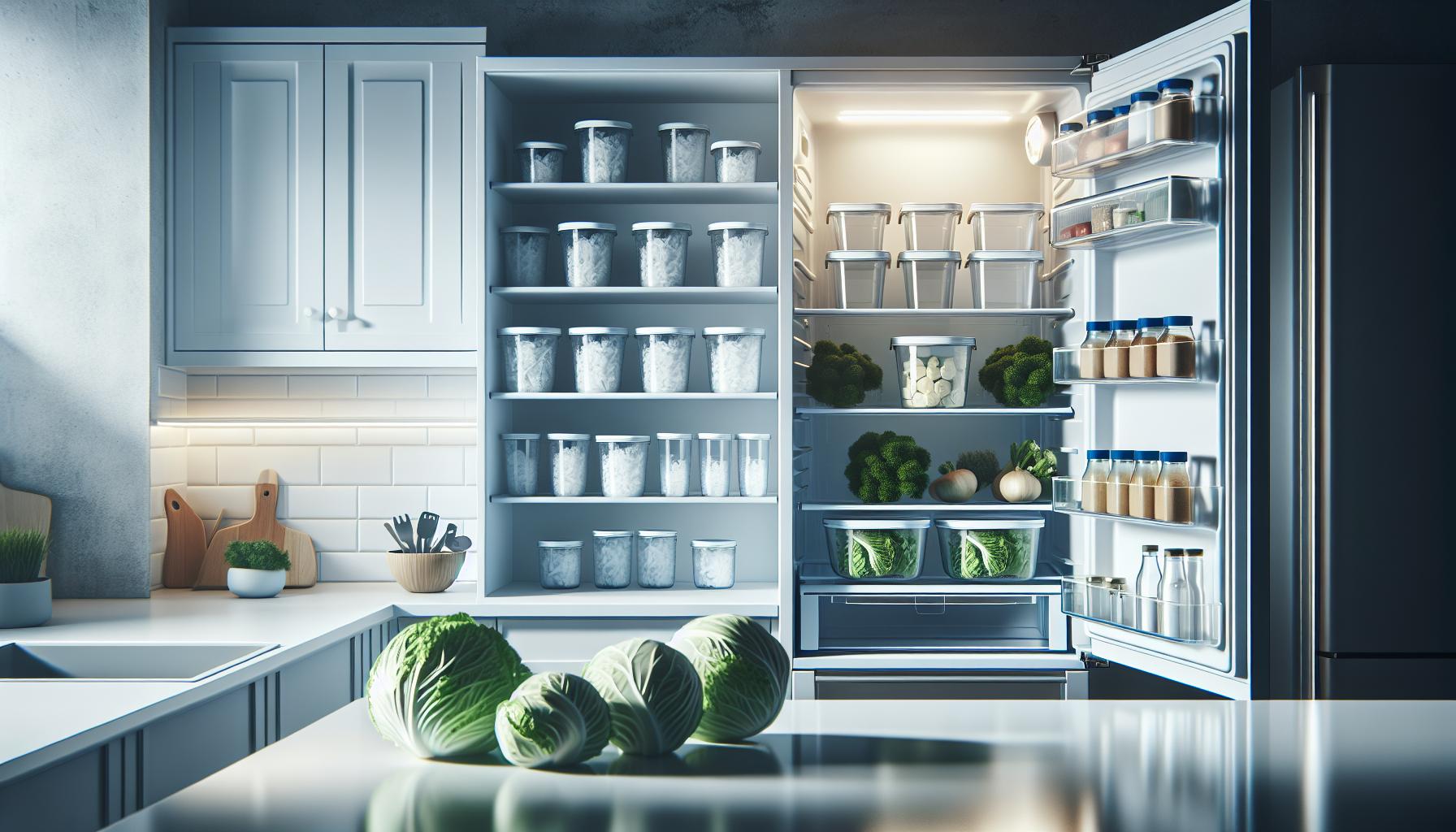
Signs That Your Sauerkraut Has Gone Bad
Identifying when sauerkraut has gone bad is crucial for enjoying its flavors while ensuring safety. While fermentation creates an environment that helps preserve the food, it isn’t foolproof. Over time, the quality of sauerkraut can deteriorate, leading to spoilage. Familiarizing yourself with the signs of spoilage will enable you to make informed decisions about your fermented foods.
The first and most obvious indicator is a change in smell. Fresh sauerkraut has a tangy, sour aroma that reflects its fermentation process. If you notice a strong, off-putting odor that resembles rotting or rancidity, it’s best to discard the batch. Additionally, visual changes can signal spoilage. Look for mold growth, which can appear as fuzzy patches on the surface or color shifts indicating bacterial activity. Healthy sauerkraut should maintain a uniform color; any significant discoloration, such as browning or black spots, could suggest harmful bacteria present.
Texture is another key factor to assess. Properly fermented sauerkraut should be crunchy and retain the texture of the cabbage. However, if it becomes slimy or mushy, it may be beyond its prime and potentially unsafe to eat. Always trust your senses; when in doubt, it’s safer to throw it away than risk your health. If you notice any of these signs, prioritize safety and discard the sauerkraut.
Lastly, consider how long the sauerkraut has been stored. Generally, homemade sauerkraut can last about 1 to 3 months in the fridge, while store-bought varieties usually last longer due to preservatives. Keeping your sauerkraut in an airtight container and submerged in its brine will help extend its shelf life. Regularly checking for spoilage signs ensures that you can continue to enjoy one of nature’s fermented delights without compromising on safety or flavor.
Optimal Storage Conditions for Sauerkraut
Storing sauerkraut properly is essential to maintain its distinct flavor and texture while prolonging its shelf life. The ideal storage conditions begin with the choice of container; using an airtight glass jar or a food-grade plastic container can significantly help in preserving the quality of your sauerkraut. Ensure that the sauerkraut is fully submerged in its brine. This not only helps lock in moisture but also creates an anaerobic environment that discourages the growth of harmful bacteria.
For best results, keep your sauerkraut in the refrigerator at a temperature of 32°F to 40°F (0°C to 4°C). The cold temperature slows down fermentation, which is crucial, especially if you are using homemade sauerkraut. Homemade varieties typically last about 1 to 3 months, while store-bought options can remain fresh for up to 6 months or even longer due to preservatives. Always check the expiration date if using store-bought sauerkraut, and remember that once opened, it should be consumed within a few weeks to ensure safety and quality.
Regularly inspecting your sauerkraut for signs of spoilage is equally important. If you see any signs of mold or a significant change in texture, it’s best to err on the side of caution and discard it. Keeping a consistent check on your sauerkraut allows you to enjoy its rich flavors without risking your health.
To optimize the longevity of your sauerkraut, be mindful of temperature fluctuations. Placing your sauerkraut in the main body of the fridge is preferable over the door, where temperatures are less stable. Additionally, if you find yourself with excess sauerkraut, consider freezing it in portions. While freezing may change its texture slightly, it can still be a viable option for longer-term storage. Remember, proper storage goes a long way in ensuring that your fermented delicacies stay fresh and safe to consume.
How to Extend the Shelf Life of Fermented Foods
To keep your fermented foods, like sauerkraut, fresh for as long as possible, understanding a few key practices can significantly enhance their shelf life. First and foremost, the choice of storage container plays a critical role. Using an airtight glass jar or a food-grade plastic container keeps the sauerkraut submerged in its brine, creating an oxygen-free environment that delays spoilage. If your sauerkraut is homemade, ensure it remains sealed tightly; exposure to air can promote the growth of undesired molds or bacteria.
Temperature Matters
One of the simplest yet most effective ways to extend the life of your sauerkraut is by maintaining the right temperature. Store it in the main compartment of your refrigerator, ideally between 32°F to 40°F (0°C to 4°C). This colder environment slows down fermentation and preserves the delicate balance of flavors while keeping your sauerkraut safe. It’s advisable to avoid placing it in the door, as fluctuations in temperature here can accelerate spoilage.
Regular Inspection
Routine checks are essential in maintaining quality. Visually inspect your sauerkraut for any signs of spoilage, including mold or off-smells. If you notice any changes, it’s safer to discard it than risk consuming spoiled food. If you have a large batch, consider using ice cube trays to freeze small portions, allowing you to thaw only what you need, thus preventing repeated cycles of exposure that lead to quicker deterioration.
Food Pairing and Use
Utilizing your sauerkraut creatively can also help reduce waste and prolong its usability. Incorporating it into various dishes, such as soups, stews, or even as a tangy topping on sandwiches, ensures that you’re enjoying its health benefits while keeping the batch from sitting idle in the fridge. Just remember, prepared dishes containing sauerkraut should also be stored properly and consumed in a timely manner to ensure food safety.
By implementing these strategies, you can enjoy the robust flavors and health benefits of sauerkraut while ensuring it stays fresh and safe to eat for an extended period.
Freezing Sauerkraut: Pros and Cons
Freezing sauerkraut can be a practical solution for preserving this tangy fermented food, allowing you to enjoy it beyond its typical refrigerator lifespan. However, while freezing offers a way to extend the shelf life of sauerkraut, it comes with a mix of benefits and potential downsides.
One of the primary advantages of freezing sauerkraut is the significant prolongation of its usability. When stored in an airtight container or freezer bag, properly frozen sauerkraut can maintain its quality for up to 8 months without substantial loss of flavor or texture. This is particularly useful if you’ve prepared a large batch or purchased sauerkraut in bulk. Additionally, freezing stops the fermentation process, which can help retain the crispiness of the cabbage and its vibrant flavors.
On the other hand, there are some drawbacks to consider. When sauerkraut is frozen, its texture may change upon thawing, often becoming softer and more mushy than when it was fresh. This is due to the formation of ice crystals that can disrupt the cell structure of the cabbage. Another point to note is that freezing can diminish some of the probiotic benefits associated with freshly fermented foods, as the freezing process can kill off some beneficial bacteria. Moreover, flavor nuances might also be altered, making the sauerkraut taste different from what you would get if consumed fresh.
To effectively freeze sauerkraut, drain excess liquid and portion it into convenient amounts. Consider using ice cube trays for smaller servings that can be thawed as needed. Always label your containers with the date of freezing to track freshness. The key to ensuring quality is to minimize exposure to air, which can lead to freezer burn-wrapped tightly in foil or stored in vacuum-sealed bags can help. Overall, by weighing these pros and cons, you can make an informed choice about whether freezing is the right preservation method for your sauerkraut.
Using Leftover Sauerkraut: Recipes and Ideas
Using leftover sauerkraut can be a delicious way to enhance meals while minimizing food waste. This tangy, fermented cabbage is not just a side dish; it can elevate numerous recipes with its distinctive flavor and health benefits. Whether you’re looking to incorporate it into hearty dishes or creative snacks, there’s a wealth of culinary possibilities to explore.
One popular method to utilize sauerkraut is in traditional dishes like Reuben sandwiches. Layering sauerkraut between corned beef and Swiss cheese on rye bread creates a perfect balance of flavors. If you’re in the mood for something warm, try making a sauerkraut and potato pierogi. The mixture of tangy sauerkraut with creamy mashed potatoes encased in a delicate dough can be boiled or pan-fried for a comforting meal.
For a quick and healthy option, adding sauerkraut to salads can provide a nice crunch and probiotic boost. Plus, it pairs well with various ingredients, whether mixed into a classic coleslaw or tossed with roasted vegetables. You might also consider using sauerkraut as a topping for baked potatoes or hot dogs, allowing its acidity to offset richer flavors wonderfully.
Finally, if you’re adventurous in the kitchen, consider baking with sauerkraut! Recipes like sauerkraut bread or dark chocolate sauerkraut cake showcase its versatility. The sour notes can enhance sweetness and moisture, creating unique and flavorful treats. Exploring these ideas can help keep your fridge fresh and your meals exciting while ensuring you make the most of your ingredients.
Comparing Store-Bought vs. Homemade Sauerkraut Storage
When it comes to storing sauerkraut, the debate between store-bought and homemade versions often warrants consideration. Both methods impart unique flavors and textures, yet they also present varying storage characteristics that can impact freshness and longevity. Understanding these differences can help you make informed decisions about which type to choose for your culinary needs and how best to store them.
Store-bought sauerkraut typically undergoes pasteurization, which extends its shelf life significantly. Once opened, it can last around 3 to 6 months in the refrigerator, retaining its quality as long as it is kept tightly sealed and submerged in brine. However, because it is pasteurized, it may lack some of the live probiotics present in unpasteurized, homemade versions. To keep store-bought sauerkraut fresh, ensure that it’s stored in a clean glass container and not exposed to air or contaminants whenever possible.
In contrast, homemade sauerkraut is raw and fermented, meaning it contains live beneficial bacteria that contribute to its tartness and health benefits. While it can also last in the fridge for about 3 to 6 months, its flavor may evolve over time as fermentation continues-often becoming more sour. To maintain the quality of homemade sauerkraut, it’s essential to store it in a tightly sealed glass jar, submerging it below the brine to prevent oxidation. Use a non-metallic lid or cover with a cheesecloth to allow gases to escape during fermentation while keeping unwanted organisms at bay.
In summary, whether you opt for store-bought or homemade sauerkraut can influence not only the taste and texture of your dishes but also how you should handle and store this tangy condiment. For optimal quality and safety, adhere to detailed storage practices that cater to the specific type you have, allowing you to enjoy its delightful tang in a variety of meals with confidence.
The Science Behind Fermentation and Food Safety
The magic of fermentation is not just about achieving the perfect tang; it’s also rooted in science, particularly when it comes to food safety. During the fermentation process of sauerkraut, cabbage is transformed by the action of beneficial bacteria, specifically Lactobacillus. These friendly microorganisms thrive in the anaerobic conditions created by submerging the shredded cabbage in its own juices. They consume the sugars present in the cabbage and produce lactic acid, which serves both to preserve the food and to create an environment hostile to pathogenic bacteria. This lactic acid not only gives sauerkraut its distinctive sour flavor but also extends its shelf life, allowing for safe storage under the right conditions.
Understanding this process can empower home fermenters and consumers alike. Proper storage methods are critical in maintaining the safety of fermented foods. Refrigerating sauerkraut slows down the fermentation process, allowing it to last longer. Properly prepared and sealed, homemade sauerkraut can last from 3 to 6 months in the fridge. For optimal safety, it should be stored in a clean, airtight container, and the cabbage must remain submerged in the brine to prevent exposure to air, which can lead to spoilage. If you notice any signs of mold on the surface, it’s essential to discard the entire batch, as this indicates that harmful bacteria may have developed.
To ensure that your sauerkraut remains safe and delicious, consider implementing a few straightforward guidelines. When opening a jar of sauerkraut, always use a clean utensil to avoid introducing contaminants. If you notice an off-smell or unusual texture-especially if accompanied by changes in color-it’s best to err on the side of caution and discard the product. By following these safety practices, both amateur fermenters and those who appreciate the convenience of store-bought options can enjoy the benefits of sauerkraut without unnecessary risk, while also indulging in the robust flavors that come from this traditional preservation method.
How to Safely Reopen and Handle Fermented Foods
When it comes to enjoying fermented foods like sauerkraut, proper handling upon reopening is crucial to maintain both safety and flavor. Each time you open a container, you introduce potential contaminants that can alter the quality or safety of your food. Therefore, understanding how to safely reopen and handle your sauerkraut not only preserves its tangy flavor but also minimizes the risk of spoilage or foodborne illness.
To begin, always ensure that you have clean utensils ready. Using a clean fork or spoon to remove sauerkraut from the jar prevents bacteria from your hands or other food items from contaminating the brine. Avoid reaching in with your fingers, as this can introduce unwanted microbes and accelerate spoilage. If the sauerkraut has been stored in a larger container, consider portioning it into smaller, airtight jars to limit the exposure to air and moisture each time you’re serving.
Once you have the sauerkraut out, check it for any signs of spoilage before using. Look for unusual colors, abnormal textures, or foul odors, which may suggest that the product has gone bad. If you observe any surface mold, do not simply scoop it off-it’s safer to discard the entire batch, as mold can penetrate beneath the surface. Remember, properly fermented sauerkraut should maintain a crisp texture and a pleasant sour smell.
After serving, promptly replace the lid and return the sauerkraut to the refrigerator. The closer you can keep the lid on without letting it sit at room temperature, the better for extending its shelf life. Stored in the fridge, homemade sauerkraut can last between 3 to 6 months, while store-bought varieties may vary based on preservatives used. Keeping your homemade batch submerged in brine will also help prevent spoilage. By following these guidelines, you can enjoy the health benefits and flavors of sauerkraut safely and sustainably.
Common Myths About Sauerkraut and Food Storage
Many people hold misconceptions about sauerkraut and its storage that can lead to unnecessary waste or food safety concerns. For instance, a common myth is that all fermented foods can be stored indefinitely. In reality, while sauerkraut is highly preserved due to its acidic nature, it does degrade over time. Homemade sauerkraut typically lasts 3 to 6 months in the refrigerator, but signs of spoilage can occur well before then, especially if not stored properly.
Another prevalent myth is that sauerkraut does not need to be refrigerated if it is in a sealed jar. While commercially jarred sauerkraut may contain preservatives that extend its shelf life, homemade or unpasteurized varieties should always be kept in the fridge to prevent harmful bacteria from proliferating. Additionally, the idea that sauerkraut is safe to eat from any point after the expiration date printed on the jar can be misleading; always inspect it for spoilage signs, such as off-odors, discoloration, or unusual textures.
People often believe that the brine will ensure sauerkraut lasts forever, but this is only partially true. The brine does help preserve the texture and flavor, but exposure to air and contaminants can lead to problems. It’s crucial to ensure that the sauerkraut is submerged in the brine to maintain its quality and extend its shelf life effectively. When stored properly and handled with care, you can enjoy this healthful condiment while avoiding common pitfalls associated with its storage.
Tips for Maintaining Quality in Fermented Foods
Maintaining the quality of fermented foods like sauerkraut is essential for both safety and flavor. With proper care, you can enjoy your homemade or store-bought sauerkraut well within its shelf life, which can typically be 3 to 6 months in the refrigerator. To maximize its freshness, start by ensuring that the sauerkraut is always submerged in its brine. This reduces the exposure to air, which can introduce unwanted bacteria and lead to spoilage. Consider using a weight or a clean stone to keep the cabbage fully submerged, particularly if the jar is not filled to the brim.
When storing sauerkraut, always opt for a clean, airtight container. If using a glass jar, ensure that the lid is tightly sealed to prevent air from entering. Regularly check for any signs of spoilage; even a small amount of unusual odor or discoloration can indicate that the quality of the sauerkraut is deteriorating. If you notice these signs, it’s best to err on the side of caution and discard it. Remember, the brine’s acidity is a natural preservative, but even acidic environments can support spoilage over time if conditions are not ideal.
Handling your sauerkraut hygienically is equally important. When you scoop out what you need, use a clean utensil to avoid introducing bacteria. Avoid double-dipping, and consider setting aside a portion in a separate dish if you’re serving it as a side. This minimizes the risk of contaminating the remaining batch. As an added tip, if you find that you have leftovers that you won’t use soon, consider transferring smaller portions to freezer-safe bags or containers. While freezing can change the texture somewhat, it is a viable method for prolonging shelf life when done correctly.
By following these practical guidelines, you can ensure that your sauerkraut maintains its distinct tangy flavor and crunchy texture, allowing you to enjoy this nutritious food safely over time.
FAQ
Q: How can I tell if sauerkraut is still good to eat?
A: To determine if sauerkraut is still safe to eat, check for off odors, discoloration, or excessive mushiness. If it looks and smells normal, it’s likely fine. Always taste a small amount if unsure; a sour but pleasant taste indicates it’s safe, while a rancid flavor suggests it’s best to discard it.
Q: Can I store opened sauerkraut in the pantry?
A: Opened sauerkraut should be stored in the refrigerator to maintain freshness and prevent spoilage. If left in the pantry, it may ferment too rapidly and develop undesirable flavors. Keep it in an airtight container in the fridge for optimal storage.
Q: What is the best way to store homemade sauerkraut?
A: Store homemade sauerkraut in a glass jar with a tight lid in the refrigerator. Ensure the sauerkraut is submerged in its brine to prevent exposure to air, which can lead to spoilage. If prepared correctly, it can last several months in the fridge.
Q: How long does vacuum-sealed sauerkraut last?
A: Vacuum-sealed sauerkraut can last up to 6 months in the refrigerator, improving its shelf life compared to non-sealed. For best quality, consume it within this timeframe. Always check for signs of spoilage before eating.
Q: Is it safe to eat expired sauerkraut?
A: Eating expired sauerkraut may not be safe. If the sauerkraut shows signs of fermentation or spoilage after the expiration date-such as unusual smells, colors, or textures-it’s best to err on the side of caution and discard it. Always use your senses to evaluate its condition.
Q: Does sauerkraut need to be heated before eating?
A: Sauerkraut can be eaten raw or heated, depending on preference. Heating can enhance its flavor and make it more palatable for some dishes, but it may reduce some of the probiotic benefits. If enjoying it raw, ensure it’s fresh and properly stored.
Q: How can I make sauerkraut last longer?
A: To extend the shelf life of sauerkraut, keep it submerged in brine and store it in an airtight container in the refrigerator. Additionally, avoid introducing contaminants by using clean utensils when serving. Consider freezing for longer-term storage, though this may affect texture.
Q: What happens if I eat old sauerkraut?
A: Consuming old or spoiled sauerkraut can lead to foodborne illness, including symptoms like nausea or stomach cramps. If you suspect your sauerkraut has gone bad, it’s best to discard it to avoid any health risks. Always prioritize food safety when consuming fermented foods.
In Conclusion
Keeping your sauerkraut fresh in the fridge is crucial for both flavor and safety. Remember, properly stored sauerkraut can last for several months, but it’s essential to keep an eye on signs of spoilage. If you’re interested in exploring more fermentation techniques or sauerkraut recipes, don’t miss our guides on DIY Fermented Foods and Creative Sauerkraut Dishes!
For those ready to dive deeper into food storage tips or even join our community, consider signing up for our newsletter for the latest insights and exclusive content. Your food safety is our priority, so share your questions or experiences in the comments below-let’s keep the conversation going! Don’t forget, the right storage practices not only enhance your meals but also empower you to enjoy the amazing health benefits of ferments.

